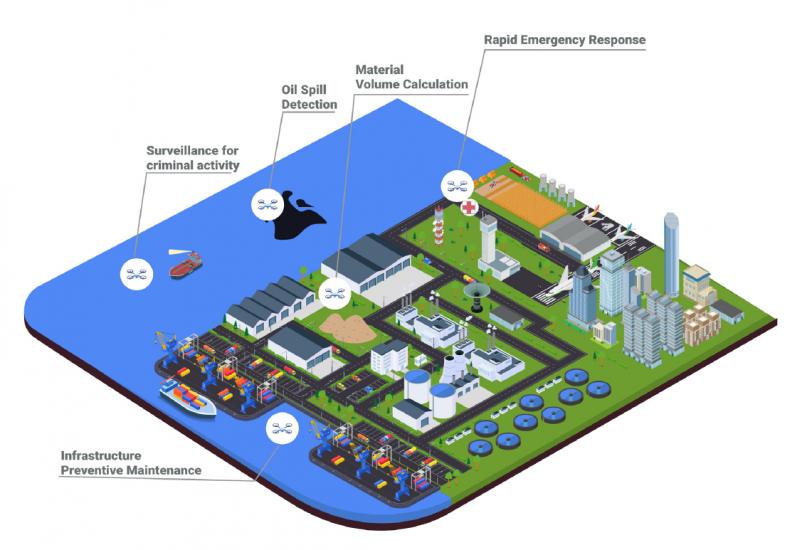Belgian UTM company Unifly has published a white paper (Unmanned Traffic Management – Empowering Drones in Ports) which outlines a concept for UAS traffic management (UTM) operations and an overview of how drones can support operations at ports. The company began working within the SAFIR consortium at the Port of Antwerp in 2019 and afterwards supported a large-scale and phased commercial rollout of drones in the port area. “This led to a precedent being set with Port of Antwerp managing its own airspace and also, kickstarted this paper on how port communities can level up by embracing drones and their benefits,” said the company.
Two key drone operations activities are the sole responsibility of the Port Authority, according to the paper, or shared with other departments such as the Port Security or the Port Police: defining conditions to fly in the port and adopting an efficient permission process. “Therefore, it is strongly recommended that a highly automated, traceable, and transparent process be applied.”
“Once a drone operator is allowed to fly within the port, it is critical to monitor that the actual flight goes according to approved flight plan. In this way, the Port Authority (or the Port Security or the Port Police) should have access to the proper systems that provide full awareness about drone flights taking place and send alerts in case of an emergency situation.”
Other key functionalities will be required of a port UTM system, according to the study:
- Protect the port against unauthorised drones
While the above two roles enable and monitor authorised drone activity, this role focuses on detecting unauthorised drones to maintain the highest level of security in and above the port area. Unauthorised drones can be divided in two categories:
- Provide and support drone services
Port tenants and contractors are not the only ones operating drones here….many Port Authorities have or are building their own drone programme.
- Connect the Port Ecosystem
The information available in the UTM system can benefit other port departments and stakeholders. Therefore, it should not operate in isolation. Beyond providing access to the system and automatic alerts in emergencies, a UTM system must be interoperable and offer the ability to integrate with the other systems used by the port.
“UTM can also act as a connecting factor or system bridge between port authorities and external authorities – with increased responsiveness and verified phone numbers in order to quickly contact drone pilots under urgent or unforeseeable circumstances. For example, relevant incident information can be exchanged with the port’s security dispatch system, or with local law enforcement and the Civil Aviation Authority in case of non-compliance with regulations. Likewise, the UTM system can receive additional data from deployed sensors or from the port’s Geographic Information System (GIS).”
| How drones can support port operations
Presently, drones assist ports in areas of environment, safety, security and infrastructure. Environment · Coastline monitoring · Spillage and leakage of oil and hazardous materials · Contamination detection · Debris monitoring and management · Compliance monitoring of emissions from ships · Exhaust and hazardous detection, particulate matter detection Safety · Rapid emergency response · Search and rescue including lifesaving devices · Delivery of medical supplies and inventory such as testing kits · Incident response and emergency management21 Security · Perimeter security and trespass response: drones act as a digital fence around the port to control access relating to International Ship and Port Security (ISPS)
Infrastructure · Ship docking management · Infrastructure and asset management, routine and preventive maintenance · Transport route supervision · Inventory volume calculation for outdoor bulk storage · Cargo and container inspection · Analysis of building and roof condition, technical structures and terminal infrastructure |
| Ports developing drone operations
· The Port of Antwerp concluded through the EU Horizon 2020 SAFIR project that drones’ ability to perform Beyond Visual Line of Sight (BVLOS) flights offer “…an immense addition to safety as they were able to manage, inspect and control a large area in a swift and safe manner.” · In 2020, Hamburg Port Authority rolled out a drone program for infrastructure inspection and facilities monitoring. · In the United States, the Police Department for Port of Los Angeles included drones in their security, emergency response, and search-and-rescue operations. · In Chile, APM Terminals began using drones for operational efficiency, as well as monitor traffic flows and container stack efficiency. · Port of Rotterdam began studying the use of autonomous trucks in the port and has been planning a large-scale deployment of the technology at the tail end of 2021. · Around the same time, the Maritime and Port Authority in Singapore deployed drones for surveillance, detection, incident response and management, and has been exploring shore-to-ship delivery applications. · The ability to fly Beyond Visual Line of Sight (BVLOS) is an important capability that is being explored in the ports of Antwerp and Singapore, while ports of Denmark, Hong Kong, the Netherlands and Norway have already been testing BVLOS operations that travel as far as 16 km out to sea for security measures like spotting offenders and criminal activity. Today, industry players acknowledge that drones can be applied beyond current uses. |
For more information
https://unifly.aero/whitepapers/ports
(Image: Unifly)




